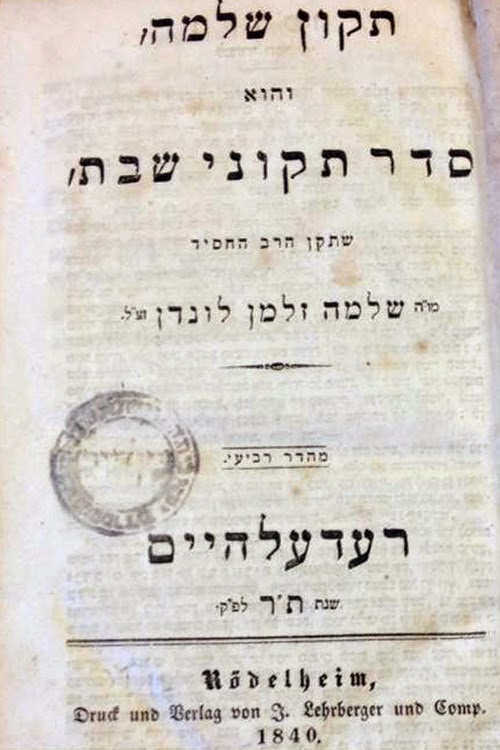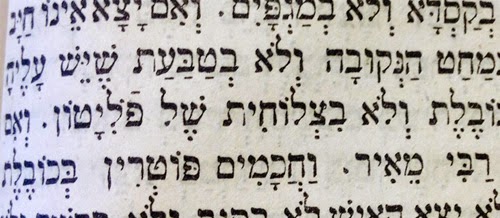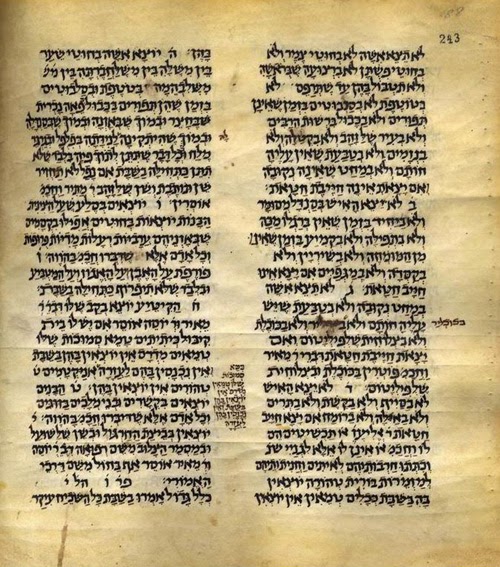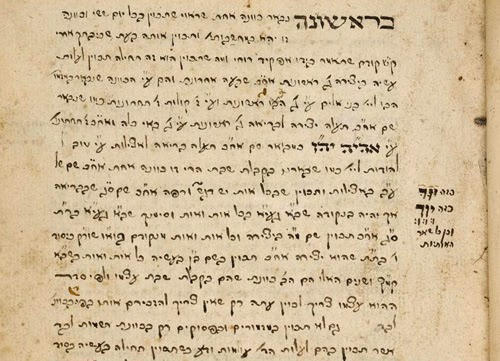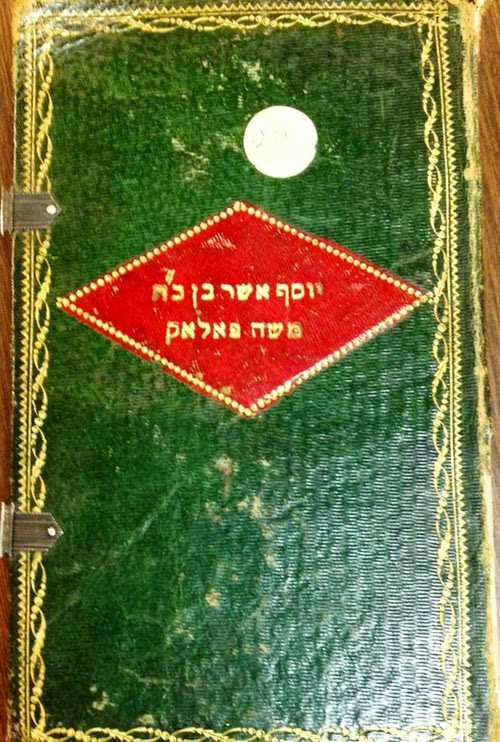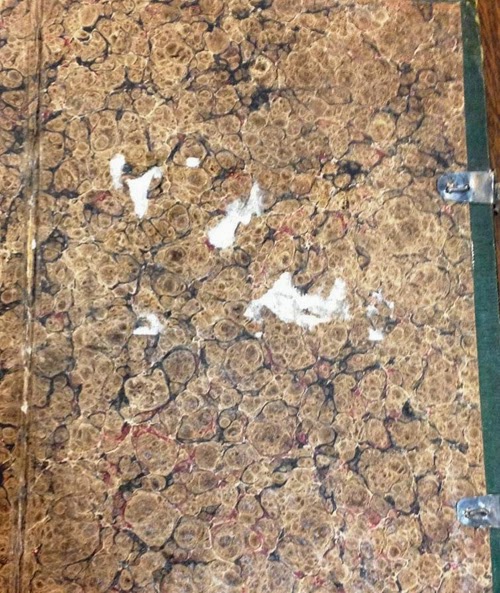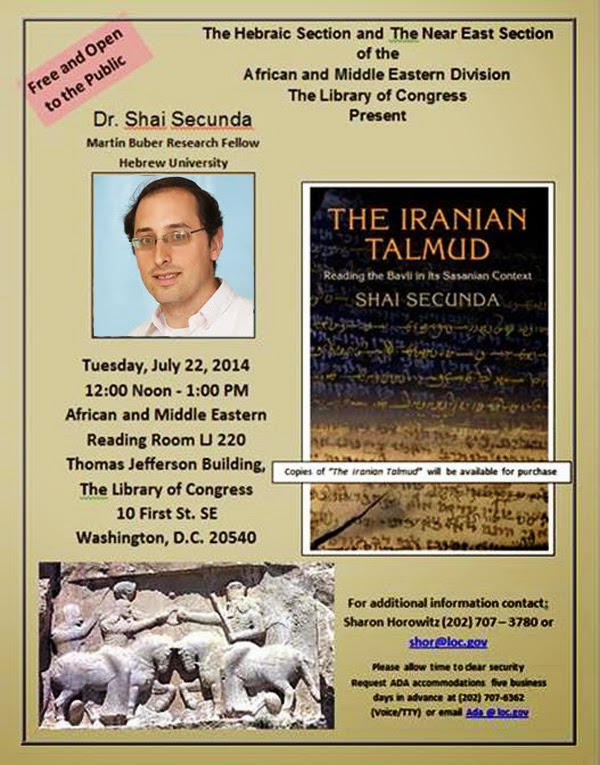הרהורים בנכר
(דפים מתוך פנקס מסעות)
מאת: טוביה פרשל
מתוך “המודיע” חנוכה
תשי”ד גליון ה 1000
א. גנזי הטיבר
1
מטייל אני על גדות הטיבר. הלילה רד על
רומא ואלפים כוכבים נוצצים ברקיע. בניני העיר מטילים צללים ארוכים על מימי הנהר,
זרועי אור הלבנה, הזוחלים לאטם.
חושך ודומיה אופפים את סמטאותיו
הקטנות והעקלקלות של הגטו שעל שפת הנהר. רק פה ושם קורעת קרן אור הפורצת מאחד
החלונות של הבנינים הגבוהים והצרים את האפלה. שומם מאין עובר הוא הכיכר הרחב לפני
בית הכנסת הגדול.
תושבי הגטו ישנים שנתם. כל היום
טרודים הם להביא לביתם לחמם הצר רק העניים שבעניי הקהילה נשארו מתגוררים בשכונה בה
גרו אבותיהם ואבות אבותיהם מאות בשנים וכאילו מוליכים גם הם דמעותיהם לטיבר הקרוב.
מה רבו הדמעות העבריות ששתה אותו נהר.
זקנה קהלת רומא העתיקה בגולת המערב ברוב תלאה וצרה.
שוכן הגטו העברי בין חורבות
ה”פורום רומנים” מרכז רומא האלילית לבין כנסיות וארמונות הואתיקן –
כאילו סמל הוא משמש ליהדות העיר שמדרס היתה לכף רגלם של שתי מלכויות עולמיות.
2
עוד מלפני אלפים שנה ראו בני הקהילה
המומי אבל ובעינים דומעות את אחיהם גבורי ירושלים, את פרוכת המקדש האדום מדם
קרבנות, השלחן הטהור, מנורת הזהב וציץ כהן הגדול מובלים שבי ברחובות המקושטים של
הקריה החוגגת.
אחוזי רעד ופחד שמעו עולות מקולוסאום
הקרקס את גניחות ואנחות אחיהם בנפלם בקרב עם אריות.
מאות בשנים אם ולב הגולה היתה עדת
רומא ועדיה הגיעו צער וכאב כל בניה. דרך שעריה באו משולחי העדות מקרוב ורחוק
מובילות שי ותחנונים לאפיפיור וחשמניו לבקש ולקנות את חסדם.
וקהלת רומא עצמה …זכות ישיבה לא
היתה לה בעיר… רק מדי שנה בשנה הורכרחה לבקש מחדש סבלנות מאת הגויים. ומדי שנה
בשנה רואה רומא הגויית את תהלוכת החרפה של יהודיה, ראשי ונכבדי הקהילה עמוסי מתנות
לאוצרות האפיפיור נגשים לשליטי הכנסיה והגמוניה ומבקשים להאריך אתם אפים עוד שנה.
3
בדומיה נשאו בני הגטו כל עלבון וצער.
גופיהם נתנו למכים ובוזים. ספרו חרפה וכלימה ודמעותיהם לטיבר הוליכו. רק פעם אחת
בשנה הראו בגלוי לגויים את המרירות שהצטברה בקרבם. ביום תשעה באב יצאו את הגטו
ומסביב לקשת טיטוס התישבו לקרוא בקול רם, באזני הגויים מגילת “איכה”,
קינות ודברי נחמה.
ורק פעם אחת במשך מאות בשנים הרימו
ראש וזקפו את הגב. לפני אלף וחמש מאות שנה היה הדבר.
גדודי הונדלים ירדו מהצפון על רומא.
ובהתקרב האויב לעיר והתפרץ בה בהלה וערבוביא – כך מספרת המסורת – קמו בני העברים
פשטו בכל עבר וחפשו במקדשי האלילים עד שמצאו כלי המקדש השבויים. לקחום מידי הגויים
וזרקום למי הטיבר – למען לא יראם עוד עין זר וערל.
לאטם זוחלים מי הטיבר. היודעים הם
הסוד הטמון בקרבם? כלי בית הבחירה צפונים במעמקיהם מיטהרים בדמעות עשרות דורות
מזוהמת הגויים.
ב. בית הכנסת בטולדו
1
שלוח שלח הקיסר רודולף לעיר היהודים
בפראג לקרוא את המהר”ל. נכנסו שניהם חדר בתוך חדר ולא נתגלה סוד שיחתם עד
היום.
מספרים כי הקיסר שאל את המקובל היהודי
סוד הפיכת עפר לזהב.
אם אמת הדבר העמיק אותו קיסר לחשוב
מכל מלכים ורוזנים שקדמוהו. אלה סחטו ומצצו כסף היהודים לוו ולא פרעו, החרימו
ולקחו בכוח זרוע ואף פעם לא שאלו: מאין להם, ליהודים, הכסף והזהב הרב, אכן הרבה
לחקור אותו קיסר ומצא. בודאי נתגלה לרבניהם אותו סוד שרבי-המגים מכל הדורות עמלו
לפענחו – ליצור זהב מעפר האדמה.
לקח המלך פדרו, המכונה האכזר, משר
אוצרו היהודי שמואל הלוי את כל רכושו וממונו וגם את ארמונו שבנה לו ולמשפחתו. עבר
אותו ארמון ממלכים לרוזנים עד שמאתיים שנה אחרי הבנותו שכן בו כבוד. אחד מגדולי
ציירי העולם, אל גרקו.
ועוד היום מראים בטולדו העיר את
הארצון שבו גר היה הצייר הגדולי ויהודי מגולי ירושלים אשר בספרד בנהו לו ולמשפחתו.
2
אבל לא בגלל ארמונו הנהדר יפקד שם
היהודי בתולדות עמו – כי אם בגלל הבית המפואר שבנה לבני עמו ולאלוקיו באותה העיר.
בית צנוע בחצוניותו אבל עשיר בתוכו עם
ציורי קיר נפלאים וקורות התקרה מארזי הלבנון.
והיה גורל אותו בית כגורל יתר הבתים,
בהם גדלו תפלה ורנה לאלוקי ישראל, בארץ ספרד. באותו יום מר ונמהר – יום ט’ באב,
יום מיועד לפורענות ודמעות מימי קדם, בו יצאו המגורשים, רבניהם וספרי תורתם בראש,
את חצי-האי, נהפך אותו מקדש להיכל לנוצרים.
3
הורו רבותינו: עתידים בתי כנסיות
שבבבל להקבע בארץ ישראל. ועוד מסורת בידינו: בועז ויכין, שני עמודי מקדש שלמה
נטועים היו גם בבית שני ובהגלות ישראל מעל אדמתו, הגלו לרומי, והנם עמודי היסוד של
כנסית פטר. ומדי שנה בשנה ביום ט’ באב זולגים הם דמעות, כי רבים הגעגועים וגדולים
הכסופים להר ה’.
שפוך שפך העם את רוחו, בנודדו בגולה
על עץ וגם על אבן. וגדולים הגעגועים ורבה הצפייה לאותו יום שבו תועלה ציונה כל אבן
שטבלה בדם ובדמע, להשלים ולפאר את בנין הכותל העזוב.
ואם באת לטולידו העיר ואתה נכנס לאותו
בית כנסת ששמואל הלוי הקימו לעמו ולאלוקיו והגויים הפכוהו לכנסייתם, תכרע ותשתחוה
על רצפת האבן ושפתותיך תשקנה מקום עמדו אבותיך בפללם – אולי תראה עיניך דמעת
האבנים ואזנך תאזין לקינתם הנוגה.
4
עומד המהר”ל בארמון הקיסר. עינו
נודדת מבעד החלון מעל גני עיר היהודים ומבטו נופל על ה”אלטניישול”, בית
כנסת קהלתו, “על תנאי” הוא בנוי. אם יבוא משיח צדקנו ייסתר ואבניו
תועלינה ירושלימה.
והוא עומד שקוע במחשבות. “מה
רוצה הקיסר החולני, אוהב בצע ורודף שלמונים. זהב ניצור מעפר בעד אוצרות מלכותו!
סוד זה לא נדע… אבל ידוע ידענו להפוך אבני גזית לאבני יקר. ואותן האבנים, קדשנו
בדם ובדמע. לא יוכלו לקחת מאתנו לעולם… שוב ישובו אלינו”.
וגם אתן אבני בית הכנסת “אל
טרנזיטו” בספרד שבאתי מרחוק לראותכן לא לעולם תהיו גלמודות ובודדות בנכר – מי
שיאסוף דמעות וצרות עמו יקבץ גם אתכן.
ג. פראג עיר המסתורין
1
מסתורין אופף את בתי הכנסת של פראג.
כשתבוא ל”אלטניישול” תחפש
לשוא את שרידי הגולם. עפרו גנוז בעליית הבית ולשם לא תוכל להגיע.
אולם תוכל לראות את כתלי בית התפלה
רוויים דם ודמעות של דורות. לפני שש מעות שנה פרצו זרים לתוך בית הכנסת ובמקום
הקדוש רצחו וחמסו ודם הקרבנות נזרק על הקירות – שש מאות שנה נמנעו יהודי פראג
מלסייד ולטייח את כותלי הבית – כדי לא לכסות על הדם הנשפך.
וכל תפלה שעלתה למרום מבית זה טבולה
היתה בדם של קדושים.
מסתורין גם אופף את בית כנסת פנחס
באותה עיר.
מצאתיו סגור ומסוגר. מאז ימי השמד
הפסיק לשמש את הקהלה. אולם לאן נעלם האוצר היקר שהיה טמון בתוכו… בגדיו של שלמה
מולכו, קדוש בישראל?
2
בשנת 1491 בעיר אבילה בספרד היה הדבר.
באחד ממאסרי האינקויזיציה שפך אנוס את לבו לפני אחיו לצרה יהודי, סנדלר לפי
מקצועו, הוא התוודה על חטאו שפרש כפיו לאל זר ובלב שלם הוא חוזר לדת אבותיו וכל
מגמתו היא לעלות לארץ הקודש. הוא מבקש את הסנדלר היהודי, שהשיארו בידו כנור לזמר
לפניו את שירת אליהו, הנאמרת במוצאי שבתות.
עשרות בשנים היה אותו שיר על אליהו,
שיבא עם משיח בן דוד, מתנגן באזניהם של האנוסים, כל חייהם היו לצפייה ארוכה
וגעגועים גדולים לגואל שיבוא לגולל מעליהם ומעל בניהם ובני בניהם את חרפת השמד
והאונס ולהכניס אל תחת כנפי השכינה את אבותיהם ואת אבות אבותיהם הקבורים בארץ טמאה
וזרה תחת הצלב והצלם. בכל מאורעות הימים דמו לראות עקבות המשיח ומכל דברם והגיגם
עלתה המיתם לקראת פעמיו.
בבוא דוד הראובני, לחצרות מלכי ספרד
ופורטוגל ובשורה בפיו: שליח משולח הוא מטעם אחיו המולך על שבטי ישראל בקצות המדבר,
להביא דברו למלכי המערב להקים ברית נגד התוגר, למען שחרר מתחת ידו את ירושלים עיר
הקודש, משתלהבת שלהבת התקוה, שהיתה עשנה בעומק נשמות האנוסים.
דיאגו פירס, סופר בחצר מלך פורטוגל,
שבהיותו בן שש נחטף מחיק הוריו וגודל על ברכי נזירים, פורע את ערלת בשרו ומטיף דם
הברית להעביר מעל גופו את המים הזדונים, מי הטבילה. הוא שם לתוגרמה פעמיו לבשר
לאחיו הגולים, כי הקיץ הקץ לגלות ישראל. ומתוגרמה הוא עובר לרומא בירת אדום.
ובהתקרבו לעיר פורצת תפלה לא-ל נקמות
בלבו. הכואב כאב עמו.
“ה’ צבאות! עד מתי אתה לא תרחם
את ירושלים ואת ערי יהודה על כל הרעות אשר עשו לנו היושבים בקרתא הזאת להצר לנו
ולזרותנו מארצנו”.
ובעיר הוא מנבא נבואות, מי הטיבר יעלו
על גדותיהם. רעש אדמה יהיה בליסבון, האותות באו בזמנם ובמקומם. הוא זורע מבוכה בין
הגויים.
3
הורה להם רבם ומוכיחם של יהודי ספרד.
הרב יצחק ערמאה: “כשם שיש לעברי בגד לימי חול ובגד לשבת בן עליו לשמור נוסף
על נמוסי הגויים, מצות התורה”.
בימי חשכת הגורל פשטו רבים את
מלבושיהם העבריים והתלבשו במחלצות הגויים. וכה הם הלכו בדרך היסורים: באין תפילין
על הזרוע ובין העינים באין אות ברית בעורם ובין ציצית בכסותם, רק אמונה בצור ישראל
בלבם, למען יראה להם את הדרך בצלמות מדבר העמים.
וכגודל צערם וסבלם כן רבתה שמחתם
בהמלטם מצפרני מעניהם, לך אמסטרדמה ותראה את פאר והדר הבית שבנו האנוסים לאלוקיהם.
ספות הרקמה ובגדי המשי של רבניו. ותדע מה רבה היתה שמחתם בשובם לחיק דת אבותיהם.
בברוח דיאנו פירס, שנקרא שמו בישראל
שלמה מולכו, מחצר מלך פורטוגל, עשה לו כתונת פסים ושני דגלים עליהם רקומים שמות
קדושים, למען ישא יהדותו ברמה. ובאותו לבוש ובאותם דגלים נלוה לדוד ראובני בדרכו
לרנגנסבורג לחצר מלך קרל החמישי.
השליחות נכשלה. החשד בהם הקיסר שהם
מרגלי התוגר? ההיה מוצדק אותו חשד? הייאמן כי משפחות האנוסים יתמכו בברית עם אויבי
נפשם, מלכי ספרד ופורטוגל, נגד תוגרמה שנתנה מחסה ומגן לרבבותיהם?
אולי לעולם לא נדע את סודו של דוד
ראובני כמו שאולי גם לא ידעו מלוהו הנלהב. דוד ראובני נתפש והובל באזיקים לספרד.
שלמה מולכו הוצא במנטובה לאש. “תתחרט, חזור לנצרות, והצל נפשך” אמר לו
שליח הקיסר כאשר עלה שלמה מולכו על המוקד. “הנני מתחרט על אותם הימים שרחוק
הייתי מעמי ומאמונת אבותי. בשמחה רבה הנני שב לביתי” ענה מולכו.
4
אמרו לו תלמידיו לרבי חנינא בן תרדיון
כשהאש אחזה בגופו ובספרי התורה סביבו: “רבי מה אתה רואה”? “גוילין
נשרפין ואותיות פורחות”.
נשרף שלמה מולכו במנטובה אבל אותיות
שמות הקדושים שבבגדיו ודגליו נשארו בחצר הקיסר ברנגסבורג. שם עוד נראו עשר שנים
אחרי מותו. אחרי שני דורות מעיד הרב יום טוב ליפמן הלר בעל ה”תוספות יום
טוב” שהוא ראה את כסותו ודגליו של מולכו בבית כנסת פנחס בפראג.
ומנהג היה באותה קהילה קדושה שבכל שנה
ושנה ביום שמחת התורה, היו באים כל הקהל אנשים נשים וטף לראות את בגדיו של קדוש
בישראל.
מי הביא אותם מרגנסבורג? מי גאל אותם
מידי הגויים ופדם מידי הקיסר? ולמה הובאו דוקא לפראג? ההיתה ידו של המהר”ל,
רבה של פראג באותו זמן בדבר?
מסתורין אופף את בית כנסת פנחס.
לעולם לא נדע מתי ומי הביא אליו בגדיו
ודגליו של מולכו וגם לא נדע על ידי מי ומתי נעלמו ממנו לפני נפול אותו בית תפלה
בשבי הגויים.
ד. בית העלמין הישן
1.
שוב הובילונו רגלי בלי משים לבית
העלמין הישן. אולי באשר הוא המקום היחידי בשכונה היהודית בפראג אשר הגויים לא חדרו
לתוכו.
רחובות הגטו התרוקנו בימי השמד האחרון
מתושביהם היהודיים. רק מנינים מצומצמים מתאספים בשני בתי הכנסת
ה”אלטניישול” ו”הויכע שול” אשר נשרדו מבתי התפלה הרבים אשר
בשכונה אשר פעם המו מרוב אדם, בודד עומד בית מועצה היהודי הישן עליו מתנוסס השעון
העברי הנודע ופעם שימש מרכז לקהילה מפוארה, בו דנו ימים ולילות נגידיה וקציניה
בעניני עדתם.
גויים שולטים היום ברחובות השכונה,
גרים בדירות היהודים, סוחרים בחנויותיהם ועובדים בבית מלאכתם.
רק בבית העלמין הישן לא נשתנה דבר.
עומד הוא על תלו כלפני מאה ומאתיים שנה.
פעם קבעו שלט קטן בשערו: אל תרגיזו את
המתים ממנוחתם.
ומעשה שהיה כך היה. בשנת 1837 בקשו
תושבי השכונה להרחיב גבולותיה. פנו לשלטונות העיר בבקשה להרשות להם להתיישב מחוץ
לתחומיה. בקשתם נתנה הורשה להם לבנות בגבולות בית העלמין הישן, באדמה שהוקצעה
למתים.
דחו היהודים בתוקף את ההצעה. הסתפקו
ברחובותיהם האפלים והצרים ועל שערי בית העלמין כתבו: אל תרגיזו המתים ממנוחתם.
וכן נשאר הדבר עד היום.
רק מעטים היהודים היום בפראג. אין שם
בית מדרש, ישיבה או תלמוד תורה. קהלה שהיתה פעם תל תלפיות בישראל הרבה ושוממה –
אולם בבית העלמין הישן לא פגעו הגויים.
2
עצים מסורבלים מסוככים על הקברות.
שבילים מכוסים עלים נובלים מתפתלים בין המצבות השקועות למחצה באדמה. שונות צורות
האבנים מרובעות, עגולות למחצה ומשולשות, מצבות גדולות וקטנות.
כבר מרחוק הנך מכיר את קברו של
המהר”ל. גלי אבנים קטנות על מצבתו מציינים אותו מבין יתר הקברות.
מי שם אלו שם בשנים האחרונות?
יהודים מהשכונה שבימי הפרעות התגנבו
לבית העלמין וערכו תפילה על יד כבר הרב בעד אחיהם ואחיותיהם שנשלחו לטרזין, מידנק
ואושבנצים?
אז אולי קבוצות הבורחים, שרידי הטבח
הגדול שבשנים שלאחרי המלחמה עשו את דרכם למערב דרך פראג, באו לכאן לשלשל פתקאות
בקשה לבקיעי המצבה טרם ימשיכו את מסעם לעתיד ולמרחקים לא ידעו מה יצפינו להם?
כפוף גב משרך אני את רגלי בין הענפים
הנמוכים בשבילים הצרים. מספרות מצבות אלו על עברה המזהיר של הקהלה החרבה, על גאון
רבניה, עושר קציניה ואצילות ונדיבות לב בניה הפשוטים ביותר.
נעצר אני לפני קברו של קצב, קצב… מה
אמרו פעם אצלנו על בני אומנתו.
ואילו זה שבקהלת פראג … נוהג היה
בכל ערב חג לחלק בין עניי העדה בשר כמשקל בני משפחתו.
כאלו היו פעם פשוטי העם בעדת פראג.
ולא רק בפראג לבד כי אם בכל קהלות ישראל באשר הן שם. לא גאונים בתורה היו, לא
נגידים בכסף – אולם גדולים ועשירים במעשים טובים.
ואולי בשל זה מוליכות אותך רגליך בכל
מקום ומקום לבתי החיים העתיקים, מתגעגע הלב לעולם יהודי נדיב ואציל שפעם היה קיים
ברחובות קצרים והאפלים של גיטאות אירופה. עולם ששקע ואינו עוד.
ה. נשמות בשבי
1
“מי זה
מעלי חיקי גנבך,
ומי שמך פרי
בטני עזובי –
ידידי מה לך
בין עם טמא לב
כתפוח בתוך
יערי חרובי
ונפשך הטהורה
בין עממים
כשושנה בין
חוחי ועשבי
נהג ולך ובוא
עדי גדודי
ברח ודמה אלי
עופר ולצבי”
כך קונן רבי יהודה אברבנאל על בנו
שהובל לשמד בליסבון. זו רק קינה אחת מאלפים ורבבות, דמעה אחת מים של דמעות ששפכו
הגולים על בני משפחותיהם וקרוביהם שבזרוע הורחקו מאתם והובלו לטבילה.
אולם הם לא נבלעו כליל בין הגויים, מי
הטבילה לא יכלו להטביע את הדם העברי שהיה נוזל בעורקיהם ולכבות את אש אמונת
אבותיהם – עוד בוערים ורועשים הם במעמקי נשמותיהם עד היום.
“ואם יגזרו שלא ינוחו תפילין, תעשה
לך סימן ותקשור חוט השני על ידך לזכר דם הברית” כותב ר’ אברהם סבע ממגורשי
פורטוגל בספרו “צרור המור”.
בחדר תוך חדר, בעליות ובמרתפים שמרו
האנוסים על יהדותם. ובאין יכולת האב לשמור ולמסור לבנו מצוות וחוקים בהלכתם מסר לו
סימנים וסמלים לבל תינתק שלשלת הזהב המאחדת את העם באשר הוא שם.
ועוד היום מצויים בידי בניהם ובני
בניהם של האנוסים שיורי מצוות. סימנים וסמלים שקבלום מאבותיהם.
שומרים הם על אלה ואינם יודעים בשל מה
– רק כשנפגשים עם יהודי הבא ממרחקים ומסתכלים במעשיו והליכותיו, עולה זכרון יהדותם
בדמם.
2
בשנים שלפני מלחמת העולם הראשונה בקר
פורטוגזי צעיר בבית כנסת “שערי תקוה” שלקהלה הקטנה בליסבון, בהתענינות
מרובה עקב אחרי תפילות ודרכי המתפללים, אחרי ימים הוא מתודע לראש העדה ושופך לפניו
את שיחו.
“אמי היתה קתולית” אמר,
“אבי היה בן אנוסים, רק אחרי מותו נודע לי הדבר. רגיל היה בימים מסוימים
בשבוע, לרוב בלילי שבתות לפרוש לחדר לעצמו, נדמה היה לי כבר אז שהוא עורך תפלות
בסתר. הוא בעצמו לא גילה לי דבר על אמונתו, כל ימי חשדתי בו שהוא מושלמי, אחרי
מותו אחזני הרצון הכביר לגלות אמונת אבותי. דת הקתוליות היתה זרה לרוחי. חפשתי דרך
לאלוקים וידעתי שעלי ללכת בעקבות אבי שהוא היה יקר לי מכל. בבית כנסת זה נגלתה
לפני אמונת אבותי, בזמן שהאזנתי לתפלותיכם, כאשר הייתי נמצא ביניכם, בני אברהם,
יצחק ויעקב עלו בנשמתי זכרונות נשכחים. לפתע שמעתי קול קורא אלי: זו היא דעת
אבותיך, היא צריכה להיום גם זו שלך”.
כאלו היו דבריו של ארטורו בסטו, קצין
בצבא ארץ מולדתו, סופר ופעיל בחייה המדיניים, שמתוך שבי הגויים בא בחזרה לעמו.
ארטורו בסטו התגייר והתמסר לתפקיד
הקדוש שנטל על עצמו להחזיר את בניהם ובני בניהם של האנוסים לדת אבותיהם. בכפרי
ועיירות המדינה בקר לעורר את אלו שדם אנוסים נוזל בקרבם ובידיהם שיורי מנהגים ומצוות
שירשו מדורות עברו.
3
נקיה אוירתה של ליסבון. נקיים להפליא
רחובותיה שזופי השמש. רוח קרירה הבאה מן הים מגרשת מתוכם כל ריח רע ואבק.
במשך עשרות ומאות בשנים פזרה רוח זו
לכל עבר את אפר הקדושים ועשן מוקדי האש והיום לא תמצאו ברחובותיה וככריה הרחבים של
העיר שריד וזכר לימי האינקויזיציה.
אולם רק למראית עין כן הדבר.
אם גם לא תגלה בכיכר “דו
רוסיה” השוקק תנועה ששמש מלפנים מושב לאינקויזיציה, דם אבותיך שנשפך שם לרוב,
לא נעלם ונאלם הוא, עודנו רועש וגועש הוא בתחתית נשמותיהם של אלפים ואולי רבבות
תושבי המדינה המפרפרות בצפרני גולה בתוך גולה.
בשולי הפנקס
(הערות)
א.
גנזי
הטיבר
הובלת כלי המקדש השבויים בתהלוכת
הנצחון ברומא מתאר יוספוס פלביוס בספרו “מלחמות היהודים”. לפי דבריו
הוצגו אחר כך בארמון הקיסר. בגמרא מסופר שרבי אליעזר ברבי יוסי ראה את הציץ ואת
הפרוכת בבית הקיסר. כמו כן מוצאים אנו באבות דר’ נתן, פרק מ”א, הלכה
י”ב: דברים העשויין וגנוזין אלו הן, אהל מועד וכלים שבו וארון ושברי לוחות
וצנצנת המן והמטה ומקלו של אהרן שקדיה ופרחיה ובגדי כהונה ובגדי כהן משיח אבל
מכתשת של בית אבטינס, שלחן ומנורה ופרוכת וציץ עדיין מונחין ברומי”.
חלוקות המסורות בנוגע לגורלם במאות
השנים הבאות.
פרקופיוס שהיה סופרו של המצביא
הביזנטי בליזר מספר בספר “מלחמות הגותים והונדלים” כי אלריך מלך הגותים
שכבש את רומא בשנת 410 למספרם הוליך אחדים מכלי המקדש לקרקיסונה. בשנת 455 שדד
גנזריך מלך הונדלים את השאר ולקחתם אתו לקרת-חדתא. בליזר כבש את העיר הזו בשנת 534
ובתהלוכת הנצחון שנערכה בביזנץ הובלו כלי בית הבחירה השבויים. יהודי מתושבי העיר
הזהיר את קרוביו של המלך יוסטינאן שהכלים מביאים אסון לבעליהם וכאשר הגיעה השמועה
לקיסר צוה להחזירם לירושלים.
מסורת אחרת מובא ב”דיקצ’יונרי
אוף דה בייבל” לסמיט בערך “מנורה”. שם מסופר שהמלך הרומי מקסנטיוס
זרק את המנורה לטיבר אחרי שנוצח על ידי קונסטטין בשעת 312 על ידי פונט מילביוס.
המלומד היהודי-צרפתי שלמה ריינק חקר בדבר אבל לא הצליח למצוא מקור המסורת. הוא פנה
לחוקר תולדות רומא המפורסם תיאודור ממוסן אולם אף הוא לא ידע מנין באה
ל”דיקצ’יונרי אוף דה בייבל” שמועה זו (ש. ריינק ברביו הצרפתי משנת
1889).
במסורת שיהודי רומא זרקו את כלי המקדש
לטיבר נתקלתי בהיותי ברומא בשנת 1949 במאמר על כלי המקדש שהופיע בעתון האיטלקי
“סו טוטו”, העתון הביא אז את הידיעה הסנסציונית שממשלת ישראל עומדת לבקש
ממשלת איטליה רשות לחפש אחרי כלי המקדש במעמקי הטיבר. העיתון ידע גם לספר כי לפני
מלחמת העולם השניה הגיש מהנדס אמריקאי תכנית לממשלת איטליה לערוך חפירות בקרקע
הטיבר במטרה לגלות את כלי המקדש ואוצרות אחרים ששליטי העיר ותושביה החביאו שם
בעלות עליה אויב, לפי דברי העתון התענין מוסוליני בתכנית אולם פרוץ המלחמה נגד חבש
מנע את בצועה. (ראה עוד להלן בסוף ההערות ל”בית כנסת בטולידו”).
-*-
יהודי רומא היו נוהגים לקרוא
“איכה” ולומר את הקינות על יד קשת טיטוס. מנהג זה נתבטל מאז המלחמה.
בנוגע אם היה קיים מנהג לא לעבור מתחת לקשת חלוקות הדעות. (עיין א. ברלינר
“תולדות יהודי רומא”).
כדאי פה לציין שיש סברה כי הקשת איננו
שער שהוקם להנציח נצחונו של טיטוס כי אם קברו של זה.
ב.
בית
הכנסת בטולידו,
בית הכנסת בטולידו הנקרא היום
“סינגוגה דל טרנסיטו” נבנה בערך בשנת 1357 למספרם על ידי ר’ שמואל הלוי
אבולפיה שר אוצרו של המלך דון פדרו האכזרי, אחרי גרוש היהודים מספרד נמסר לכנסיה
ועד מלפני ששים שנה שימש בית תפלה לנוצרים. בסוף המאה הקודמת הרחיקו ממנו את פולחן
הגויים והסירו את הטיח והסיד שבהם כסו הנוצרים את הכתבות העבריות שעל הקירות.
פרופ’ א. ל. יהודה ז”ל ששנים
רבות עשה בספרד, פרסם בספרו “עבר וערב” מחקר מקיף על תולדות וכתבות בית
הכנסת.
כתבה שהיא לימין מקום ארון הקודש
קוראה:
ראו מקדש אשר
נקדש בישראל
והבית אשר בנה
שמואל
ומגדל עץ
למקרא דת בתורה
ותורותיו למו
א-ל
ומזרקיו
ונרותיו להאיר
וחלונותיו
כחלוני אריא-ל
שונאי שמואל הלוי בחצר המלך העלילו
עליו שהוא טומן בארמונו אוצרות המלך וזה השליך אותו למרתפו ויענהו על מות.
אברהם זכותא כותב בספר היוחסין דברים
אלו על שמואל הלוי:
“דון פדרו הרג ביסורין בבית
הסוהר לר’ שמואל הלוי שעשה בית הכנסת בטולטולה ובתי כנסיות אחרים בקסטיליא וטובות
גדולות לישראל ומיד לקח הקב”ה נקמה מהמלך דון פדרו שהרגו אחיו”.
-*-
על הפגישה בין המהר”ל מפראג
והקיסר רודולף כותב ר’ דוד גנז ב”צמח דוד”:
“אדוננו הקיסר הישר המאור הגדול המהולל רודולפוס יר”ה ברוב חסדו
ואמיתו שלח וקרא אליו את הגאון מה”ר ליווא ב”ר בצלאל וקבלו בסבר פנים
יפות ושוחקות ודבר עמו פה אל פה כאשר ידבר איש אל רעהו ומדות ואיכות הדברים
סתומים, חתומים נעלמים הם. והיה זה פה ק”ק פראג ביום א’, ג’ אדר שנת
שנ”ב”.
-*-
בכנסית פטר ברומא מונחת אבן ואומרים
עליה שהיא שבר מעמוד בית המקדש.
מסורת דומה במקצת לזו שהזכרנו על
העמודים הבוכים מובא בספר המסעות לר’ בנימין מתודלה.
ר’ בנימין מוסר על ביקורו ברומא:
ושם שנקג’ון דלטרנה (שמה של כנסיה) ובבמה שני עמודים מנחושת ממעשה שלמה
המלך ע”ה ובכל עמוד חקוק שלמה בן דוד ואמרו לי היהודים אשר ברומא כי בכל שנה
ושנה בימי תשעה באב נמצאה זיעה עליהם נגרת כמים – ושם מערה שגנז בתוכו טיטוס בן
אספסינוס כלי בית המקדש שהביא מרומא.
-*-
ג. פראג עיר המסתורין
אין לך קהלה בישראל ששר האגדה עטרה
והקיפה שמועות וספורים כפראג. רבות האגדות על בתי כנסיותיה, רבניה, קציניה ותושבי
הגטו הפשוטים. רבים הספרים שנכתבו על אודותם (“ספורים” של פשלס, הספרים
הרבים על המהר”ל והגולם ועוד).
בנגוע לשרידי הגולם יש שתי מסורות
שונות לפי האחת נגנזו בעליית “האלטניישול” ולפי האחרת הבריחו אותם משם
אברהם בן זכריה, שמש המהר”ל ואברהם חיים וקברום בסתר ב”גלגנברג”
בסיבת פראג… העתונאי והסופר א. א. קיש הלך פעם ל”חפש” את שרידי הגולם.
חפושיו תאר בספרו “דר רזנדר רפורטר”.
-*-
שלוש פעמים מזכיר ה”תוספות יום
טוב” בספרו “דברי חמודות” על הלכות ציצית להרא”ש כי הוא ראה
את בגדיו של שלמה מולכו.
בס”ק כ”ה: פה ק”ק פראג
בבהכ”נ דפינחס שהייתי רגיל בה קודם שנתמניתי לאב”ד יש ארבע כנפות
ממשי… והובא לכאן מרגנסבורג והוא של הקדוש רבי שלמה מולכו הי”ד עוד שני
דגלים שלו וגם סרגינוס שקורין קיטל”.
בס”ק מ”ח: אבל ראיתי
ציציותיו של הקדוש רבי שלמה מולכו זצ”ל.
בס”ק נ”ח: וגם אנכי הרואה
כן בטלית קטן של הקדוש ר’ שלמה מולכו זצ”ל שיש פה בבית הכנסת והוא נקרא
בהכ”נ דפינחס וכבר הזכרתי זה לעיל ס”ס כ”ה.
בעל “צמח צדק” שהיה בן פראג
והמרחיב בספרו את הדבור על ר’ שלמה מולכו וגם כותב שראה אצל אחד מקרוביו את ספר
הקבלה שחבר איננו מזכיר שלבושיו נמצאים בבית הכנסת פינחס, לכן נראה שבזמנו טרם
הובאו לפראג.
לפי זה נוכל אולי להגביל את זמן הבאתם
מרגנסבורג לפראג בין שנ”ב, השנה בה סיים ר’ דוד גנז את ספרו לשנת שפ”ט,
אז גלה ר’ יום יטוב ליפמאן הלר מפראג. היות והתוספות יו”ט מדבר על המצאם של
הבגדים כעובדה הידועה מכבר יש לצמצם את זמן העברתם לשנים הראשונות של התקופה
הנזכרת לעיל. (כידוע היה ה”תוספות יום טוב” עד טרם שנתקבל לאב”ד
פראג ושימש במשרה זו בערים אחרות, דיין אותה קהל בשנת שנ”ח).
באגרת משנת תכ”ו שנשלחה מוינה
נמסר כי ה”תוספות יום טוב” בקש פעם להעתיק את שמות הקדושים אשר על
הלבושים אבל הנייר וקסת הסופר שלו נסתתמו ונעלמו מעיניו באופן “שלא נודע עד
היום היכן הלכו” (י. שלם ב”ציון” כרך י. וש. ח. קוק ב”רשומות”
סדרה חדשה. תאור מפורט של בגדי שלמה מולכו נמצא בספרו של פדיברנד “יוד.
אלטרטימר אין פראג).
-*-
ד. בית העלמין הישן.
השלט בן שלוש שורות בעברית וגרמנית
המזהיר לא להפריע את המתים ממנוחתם נקבע על פי פקודת הרב שמואל לנדוי בנו של
ה”נודע ביהודה” רבה של פראג באותה תקופה.
הנני להביא את נוסח המצבה של אותו קצב
נדיב לב.
…אב ונקבר ביום עשרה למנחם אב תי”ו לפ”ק.
נפטר היקר כמר דוד כ”ץ קצב בן היקר כמר והנעלה כ”ה משה קרוב כץ
זצ”ל.
ויהי דוד עושה צדקה בכל עת, תמיד, יתומים זן ומפרנס, אוהב רבנים ורחים
רבנים, ומשגר להם מתנות בכל עת. בכל יום טוב שקל בניו ובנותיו, ונתן בשבילם בשר
לקופה ובתי הקדשות. ואף הוא עשה מנורה של נחושת בבתי הכנסת הישנה ונתן בכל שנה שמן
זית להעלות נר תמיד בכל עת לכן
תנצב”ה
(מתוך הספר “גל עד” מאה
ושבעה כתבי לוחות אבני זכרון בשדה הקבורה הישן כאן, מאת קופל ליבן והקדמה מאת
שי”ר, פראג ה’ תרט”ז).
-*-
ה. נשמות בשבי
רבות נכתב במשך שלושים השנה האחרונות
על “הנוצרים החדשים” מנהגיהם ומנהיגם ארטורו ברוס (בר ראש) בפורטוגל.
המהנדס שמואל שוורץ שהיה גר בליסבון היה ראשון העושים למענם. ועד שנוסד בלונדון
בשנות העשרים עזר ל”אנוסים” להקים בתי כנסת משלהם בכפרים בצפון המדינה
ובעיר הנמל אופטרו. שמואל שוואץ שחבר ספרים חשובים על האנוסים בפורטוגל מת לפני
חצי שנה בליסבון.
-*-
רבי אברהם סבע מחבר “ספר צרור
המור” מספר בהקדמתו לפרושו “צרור הכסף” למגילת אסתר (טרם נדפס)
ש”שני בני קירות לבבי לקחום בעל כרחם להמיר דתם ולא ראיתים יותר”.
דבריו שצטטנו בפנים כי בשעת הגזרה
יקשרו חוט השני על הזרוע במקום התפילין מובאים בפרשת “עקב” על הפסוק
“ושמתם את דברי אלה על לבבכם ועל נפשכם וקשרתם אותם לאות על ידכם והיו
לטוטפות בין עיניכם” נראה הדבר (אין הספר כעת תחת ידי לעיין בו מחדש) שהוא מפרש
את דברי הספרי הנזכרים ברש”י – ושמתם את דברי, אף לאחר שתגלו הוו מצויינים
במצוות הניחו תפילין, עשו מזוזות כדי שלא יהיו לכם חדשים כשתחזרו. וכן הוא אומר
“הציבי לך ציונים” – באופן כזה כי בגלות אם לא תהיה אפשרות לקיים את
המצוות כהלכתן, אף על פי כן “הניחו תפילין” באופן סמלי על ידי קשירת חוט
השני ועל ידי כך לא תשתכחנה מכם המצוות. פירוש זה בספרי מסיר ממנו כל הקשיים
שהתקשו בהם האחרונים.






